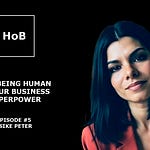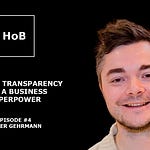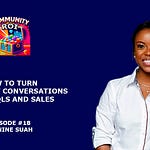“One of the things that I hear a lot from other teams is that I don't wanna get in the community, "I just want the community to do stuff for me because I don't have the time to answer questions."
Other teams need to realize that the community is not a catch-all for all the things that you can't push through all of the other red tape within your organization. You really need to understand how engaging with them is going to help not only further your goals, but their goals.
They are not there to wait and sit and wonder if the senior director of marketing is gonna come in so that 500 people can then jump in and ask a question of. All they wanna know is can they get their questions answered?
So just come with an open mind and know that they've got goals to complete and to achieve just like you do. And so approach it with the same level of care and thought that you would any other team member, but it's okay to have the conversation where it makes sense.“
From this episode, you'll know:
👉 Why not every company needs a community.
👉 How to measure community success using both data and emotional feedback.
👉 Practical tips for encouraging cross-team collaboration without adding extra workload.
👉 How to speak the language of both community and business leaders.
👉 Why great community work often feels invisible but drives massive business value.
Choose the best platform to listen to this episode:
Connect with Marjorie and Yurii here:
https://www.linkedin.com/in/marjorie-anderson-she-her/
https://www.linkedin.com/in/yurii-lazaruk-community-consultant/
From Buzzword to Business Growth: How to Connect Community Goals with Business Impact
When I sat down with Marjorie for the latest episode of The Community ROI Podcast, I expected insights.
What I got was a masterclass in how to truly connect community goals with business strategy—delivered with honesty, depth, and a whole lot of heart.
From the very first minute, I could feel her passion for people-centered ecosystems.
“Community is not just about more people or more engagement,” Marjorie said.
“It’s about solving the problems people originally came to you for—and then building relationships that go deeper than transactions.”
That sentence alone flipped a switch.
❌ Not Every Company Needs a Community
One of the most refreshing moments in our conversation was when Marjorie said what many community professionals often think—but few say out loud:
“Sometimes community is not the answer. Sometimes you need better marketing or customer acquisition. But if you’re not clear on why you’re building a community, you probably shouldn’t be building one.”
She shared the three questions she always asks before helping any organization build a community:
Why does the community exist, and why now?
Who is it meant to serve?
How will it be nurtured into the future?
If those answers are fuzzy, a community might not be your magic bullet.
🔁 Community Doesn’t Fix Broken Strategy
We laughed (and sighed) over how often companies treat community as the ultimate fix-all:
“If you’ve got a crappy product or sales strategy, community won’t save you,” I added.
“It’ll help you amplify what’s already working—but it won’t cover the cracks.”
Marjorie wholeheartedly agreed, noting that communities can accelerate business growth, but they can't replace foundational clarity.
🎯 Defining Goals That Matter
So what is a community goal?
According to Marjorie, it starts with purpose. At the macro level, it’s why the community exists and who it serves. At the micro level, it’s how you measure if that purpose is being fulfilled.
“You can’t define community goals without considering both the organization’s needs and the community’s needs,” she said.
“It has to be mutual value—or it won’t be sustainable.”
🏃 A Real-World Example: Building Wellbeing Communities at Work
Marjorie shared her work at EXOS, a leader in corporate wellbeing. There, she helps people inside large organizations come together around health, fitness, and mental wellness, often empowering natural leaders to create meaningful experiences.
One initiative stood out: the Shared Meal Concept, inspired by Charles Vogl’s work. It brought people together for intentional, non-work-focused connection, and the results were powerful.
“People told us, ‘I didn’t know I needed this until I experienced it,’” Marjorie recalled.
“That’s the power of intentional community design.”
📊 Proving ROI (or… Impact)
When the conversation turned to ROI, Marjorie offered a paradigm shift:
“ROI usually stands for return on investment. But in community work, try replacing ‘investment’ with impact.”
Suddenly, the scope broadens. It’s not just about revenue. It’s about retention, engagement, brand love, connection, and innovation.
Still, she didn’t shy away from metrics. She described a previous role where the community platform triggered membership upgrades by offering premium content. When users clicked a webinar and hit a paywall, the system tracked conversions. Result?
“Every month, we could say: this many members joined or renewed because of community actions. That’s real data. That’s impact you can show leadership.”
🔁 Community Is a Cross-Functional Sport
One of the key takeaways was the importance of internal partnerships.
“Community touches everything—marketing, UX, content, product. It can’t work in a silo.”
She urged community teams to build strong internal relationships—not to beg for support, but to offer it. Ask internal teams: What are your goals? How can community help you reach them?
The magic lies in “help me help you”.
“Community teams often hear things that no one else hears,” she noted.
“That’s why we’re so valuable—but also why we need to collaborate intentionally.”
🌲 Facing the Challenges with Perspective
Every community builder hits walls. Marjorie calls them “giant oak trees.”
“You’re walking through the forest, and suddenly there’s this massive tree in your way. You think: how do I chop it down? But sometimes you just need to step to the left or right—and walk around it.”
That metaphor stuck with me. It’s about seeing the big picture and not getting paralyzed by obstacles.
And when it gets tough?
“I remind myself: people deserve to feel seen, heard, and like they matter. That’s why I do this work—even when it’s hard.”
💡 Final Advice for Measuring Community Value
If you’re struggling to identify community ROI, Marjorie suggests you zoom out:
“Start by reframing ROI as Return on Impact. Then ask: where does our community work already contribute to the business? And how can we track that intentionally?”
Sometimes that means asking your CRM admin to add a “community member” field. Sometimes it means building better attribution. But it always means learning to speak the language of business.
🧠 Key Takeaways
Start with purpose: If you don’t know why the community exists, don’t build one yet.
Align micro and macro goals: Purpose drives the vision; KPIs prove the value.
Community isn't a silo: Build relationships with internal teams.
Track impact, not just investment: ROI ≠ revenue only.
Conversations are the secret weapon: Most value starts with listening.
Start small: One action, one insight, one connection at a time.
If you’re a community builder—or a business leader curious about how community really drives growth—this episode is your blueprint 🚀















Share this post